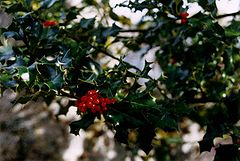Ilex aquifolium
| Ilex aquifolium subsp. var. | Holly, European Holly, Christmas Holly | |||||||||||||||||||||||||||||||||||||||||||||||||||||||
|---|---|---|---|---|---|---|---|---|---|---|---|---|---|---|---|---|---|---|---|---|---|---|---|---|---|---|---|---|---|---|---|---|---|---|---|---|---|---|---|---|---|---|---|---|---|---|---|---|---|---|---|---|---|---|---|---|

|
|
| ||||||||||||||||||||||||||||||||||||||||||||||||||||||
| ||||||||||||||||||||||||||||||||||||||||||||||||||||||||
Ilex aquifolium (Holly, or European Holly to distinguish it from related species, may also be called Christmass Holly or Mexican Holly) is a species of holly native to western and southern Europe, northwest Africa and southwest Asia.[1][2][3][4]
It is an evergreen tree growing to 10-25 m tall and 40-80 cm (rarely 1 m or more) trunk diameter, with smooth grey bark. The leaves are 5-12 cm long and 2-6 cm broad, variable in shape; on young plants and low branches, with three to five sharp spines on each side, pointing alternately upward and downward; on higher branches of older trees with few or no spines except for the leaf tip, often entire.[3][4]
The flowers are dioecious, white, four-lobed, and pollinated by bees. The fruit is a red drupe 6-10 mm diameter, containing four pits; although mature in late autumn, they are very bitter due to the ilicin content[5], and so are rarely touched by birds until late winter after frost has made them softer and more palatable.
| Standard Cyclopedia of Horticulture |
|---|
|
Ilex aquifolium, Linn. English Holly. Tree, to 40 ft., with short, spreading branches, forming an oblong or pyramidal head, in cult, often shrubby, glabrous: lvs. short-petioled, usually ovate or oblong- ovate, waved and with strong, spiny teeth,- shining, in. long: fr. scarlet, globular, shining. May, June. a. and Cent. Eu., W. Asia, China.—A very variable species. Osmanthus aquifolium, Sieb. & Zucc., an oleaceous shrub, which may readily be known by its opposite Ivs., is occasionally supplied by dealers as a variety of Ilex Aquifolium.
|
Cultivation
Propagation
Pests and diseases
Varieties
Gallery
-
European Holly flowers; male above, female below (leaves cut to show flowers more clearly)
-
photo 1
-
photo 2
-
photo 3
References
- ↑ Flora Europaea: Ilex aquifolium
- ↑ Med-Checklist: Ilex aquifolium
- ↑ 3.0 3.1 Rushforth, K. (1999). Trees of Britain and Europe. Collins ISBN 0-00-220013-9.
- ↑ 4.0 4.1 Flora of NW Europe: Ilex aquifolium
- ↑ Heinz, A. (1975). Drogenkunde. W. de Gruyter ISBN 313566001X
- Standard Cyclopedia of Horticulture, by L. H. Bailey, MacMillan Co., 1963
External links
- w:Ilex aquifolium. Some of the material on this page may be from Wikipedia, under the Creative Commons license.
- Ilex aquifolium QR Code (Size 50, 100, 200, 500)

